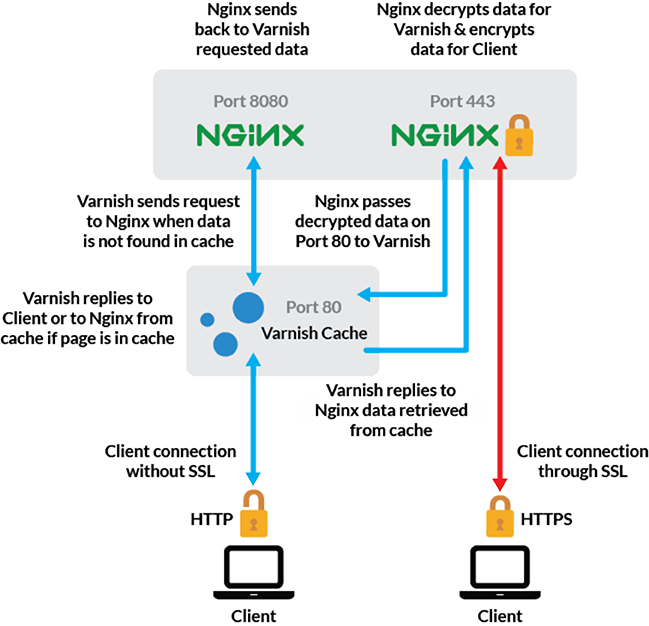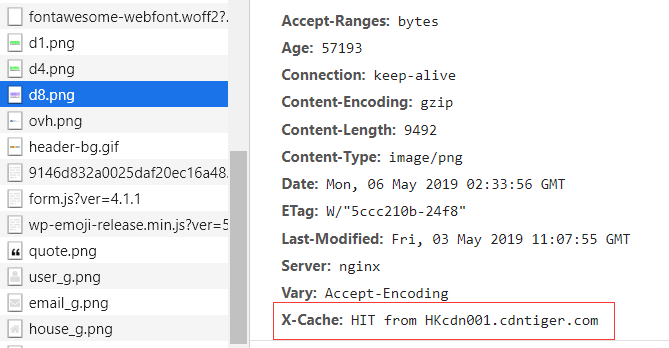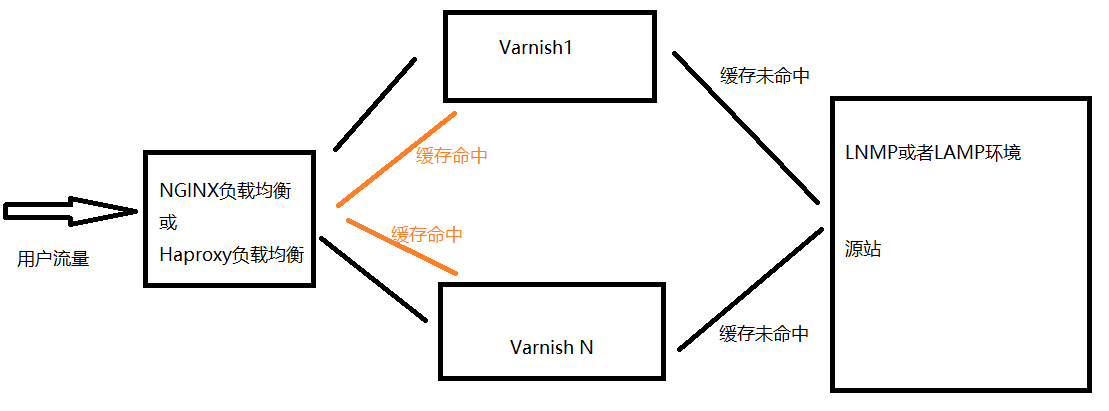在构建CDN系统的架构上,Varnish和squid会使用得是最多的,它们各有优劣点,本文以Varnish为基础创建Varnish的CDN,加速网站,可以用DNS解析的方式,把吃灰小鸡利用起来,比如某小鸡对移动线路优秀,那么把来自移动的流量导向此小鸡,联通电信同理,在结合Varnish集群,大大减轻源站的负载压力并合理利用吃灰小鸡。
Varnish架构图
集群实验环境:Centos-7.6 Varnish-6.2 Nginx-1.16.0
一般情况下,会在Nginx或者Haproxy负载均衡层,进行心跳检测和浮动IP,而且会加上健康检测,来避免宕机的危险,正常流程是外网映射内网,内网机器之间实现LVS的VIP功能,由于本站小鸡全部是外网,没有内网所以只能实现在外网之间的通信。
流程:
http->https->varnish集群->源站
https->varnish集群->源站
由于Varnish 暂不支持 https协议,收费版支持https协议,所以我们用Nginx来反代实现HTTPS协议,Nginx负载均衡鸡配置如下:

cat /etc/nginx/conf.d/yunwei114.conf
server {
listen 80;
server_name xqt.io xqt.io;
rewrite ^/(.*) https://xqt.io/$1 permanent;}
upstream yunwei114_com
{# ip_hash;
server 127.0.0.1:6081;
server Varnish节点外网IP:6081;}server {
listen 443 ssl http2 fastopen=3 reuseport;
server_name xqt.io xqt.io;
error_log /var/log/nginx/error.log crit;
ssl_certificate /etc/letsencrypt/live/xqt.io/fullchain.pem;
ssl_certificate_key /etc/letsencrypt/live/xqt.io/privkey.pem;
ssl_trusted_certificate /etc/letsencrypt/live/xqt.io/chain.pem;
ssl_dhparam /etc/nginx/ssl/dhparam.pem;
ssl_protocols TLSv1.2;
ssl_prefer_server_ciphers on;
ssl_ciphers "ECDHE-ECDSA-CHACHA20-POLY1305:ECDHE-RSA-CHACHA20-POLY1305:ECDHE-ECDSA-AES128-GCM-SHA256:ECDHE-RSA-AES128-GCM-SHA256:ECDHE-ECDSA-AES256-GCM-SHA384:ECDHE-RSA-AES256-GCM-SHA384:DHE-RSA-AES128-GCM-SHA256:DHE-RSA-AES256-GCM-SHA384:ECDHE-ECDSA-AES128-SHA256:ECDHE-RSA-AES128-SHA256:ECDHE-ECDSA-AES128-SHA:ECDHE-RSA-AES256-SHA384:ECDHE-RSA-AES128-SHA:ECDHE-ECDSA-AES256-SHA384:ECDHE-ECDSA-AES256-SHA:ECDHE-RSA-AES256-SHA:DHE-RSA-AES128-SHA256:DHE-RSA-AES128-SHA:DHE-RSA-AES256-SHA256:DHE-RSA-AES256-SHA:ECDHE-ECDSA-DES-CBC3-SHA:ECDHE-RSA-DES-CBC3-SHA:EDH-RSA-DES-CBC3-SHA:AES128-GCM-SHA256:AES256-GCM-SHA384:AES128-SHA256:AES256-SHA256:AES128-SHA:AES256-SHA:DES-CBC3-SHA:!DSS";
ssl_session_cache shared:SSL:10m;
ssl_session_timeout 10m;
# OCSP Stapling ---
# fetch OCSP records from URL in ssl_certificate and cache them
ssl_stapling on;
ssl_stapling_verify on;
location /status {
stub_status on;
access_log off;
}
location / {
proxy_pass http://yunwei114_com;
proxy_set_header X-Real-IP $remote_addr;
proxy_set_header X-Forwarded-For $proxy_add_x_forwarded_for;
proxy_set_header X-Forwarded-Proto https;
proxy_set_header X-Forwarded-Port 443;
proxy_set_header Host $host;
}}
Varnish节点,只需要安装Varnish即可,并按以下进行Varnish节点配置,Varnish(1-N)配置文件一致,唯一不一致的是运行配置文件,运行配置文件需要指定监听Varnish节点外网IP,配置如下:
###Varnish配置文件:cat /etc/varnish/default.vcl
vcl 4.0;backend default {
.host = "源站外网IP";
.port = "8081";
.connect_timeout = 600s;
.first_byte_timeout = 600s;
.between_bytes_timeout = 600s;
.max_connections = 128;}acl purger {
"localhost";
"127.0.0.1";}sub vcl_recv {
if (req.method == "PURGE") {
if (!client.ip ~ purger) {
return(synth(405, "This IP is not allowed to send PURGE requests."));
}
return (purge);
}
if (req.restarts == 0) {
if (req.http.X-Forwarded-For) {
set req.http.X-Forwarded-For = client.ip;
}
}
if (req.http
.Authorization || req.http.Cookie ~ "wordpress_logged" || req.http.Cookie ~ "comment_") {
/* Not cacheable by default */ return (pass);
}
if (req.url ~ "/feed") {
return (pass);
}
if (req.url ~ "wp-admin|wp-login") {
return (pass);
}
if (req.url ~ "^(.*)\.(jpg|png|gif|jpeg|flv|bmp|gz|tgz|bz2|tbz|js|css|html|htm)($|\?)" ) {
#移除cookie,以便能缓存到varnish
unset req.http.cookie;
}
set req.http.cookie = regsuball(req.http.cookie, "wp-settings-\d+=[^;]+(; )?", "");
set req.http.cookie = regsuball(req.http.cookie, "wp-settings-time-\d+=[^;]+(; )?", "");
if (req.http.cookie == "") {
unset req.http.cookie;
}}sub vcl_purge {
set req.method = "GET";
set req.http.X-Purger = "Purged";
return (restart);}sub vcl_backend_response {
set beresp.ttl = 24h;
set beresp.grace = 1h;
if (bereq.url !~ "wp-admin|wp-login|product|cart|checkout|my-account|/?remove_item=") {
unset beresp.http.set-cookie;
}}sub vcl_deliver {
unset resp.http.Via;
unset resp.http.X-Varnish;
if (obj.hits > 0) {
set resp.http.X-Cache = "HIT from " + server.hostname;
} else {
set resp.http.X-Cache = "MISS from " + server.hostname;
}}sub vcl_synth {if (resp.status == 404) {
set resp.http.Content-Type = "text/html; charset=utf-8";
set resp.http.Retry-After = "5";
synthetic( {"<!DOCTYPE html>
<html>
<head>
<title>"} + resp.status + " " + resp.reason + {"</title>
</head>
<body>
<h1>Error "} + resp.status + " " + resp.reason + {"</h1>
<p>"} + resp.reason + {"</p>
<h3>Guru Meditation:</h3>
<p>XID: "} + req.xid + {"</p>
<hr>
<p>Varnish cache server</p>
</body>
</html>
"} );
}
return (deliver);
}
Varnish运行配置文件:
### Varnish运行配置文件,如果Nginx负载均衡鸡和Varnish在同台机器,那么Varnish鸡运行配置文件不需要指定IP,默认是127.0.0.1:
ExecStart=/usr/sbin/varnishd -a :6081 -f /etc/varnish/default.vcl -s file,/tmp/varnish/cache.bin,5G
### Varnish运行配置文件,如果Nginx负载均衡鸡和Varnish不在同台机器,那么Varnish鸡需要指定运行配置文件的外网IP:
cat /usr/lib/systemd/system/varnish.service
ExecStart=/usr/sbin/varnishd -a 外网IP:6081 -f /etc/varnish/default.vcl -s file,/tmp/varnish/cache.bin,5G
源站Nginx配置文件:
cat /etc/nginx/conf.d/yunwei114.conf
server {
listen 8081;
server_name xqt.io;
port_in_redirect off;
location / {
root /home/yunwei114;
index index.php index.html index.htm;
try_files $uri $uri/ /index.php?$args;
}
#error_page 404 /404.html;
# redirect server error pages to the static page /50x.html
#
error_page 500 502 503 504 /50x.html;
location = /50x.html {
root /usr/share/nginx/html;
}
# proxy the PHP scripts to Apache listening on 127.0.0.1:80
#
#location ~ \.php$ {
# proxy_pass http://127.0.0.1;
#}
# pass the PHP scripts to FastCGI server listening on 127.0.0.1:9000
## location ~ \.php$ {
location ~ .*\.php(\/.*)*$ {
root /home/yunwei114;
# try_files $uri =404;
# fastcgi_split_path_info ^(.+\.php)(/.+)$;
fastcgi_index index.php;
fastcgi_param HTTPS on;
fastcgi_pass unix:/dev/shm/php7-fpm.sock;
fastcgi_param SCRIPT_FILENAME /home/affdalao$fastcgi_script_name;
include fastcgi_params;
}
# deny access to .htaccess files, if Apache's document root
# concurs with nginx's one
#
#location ~ /\.ht {
# deny all;
#}
}
检验Varnish集群是否生效,关闭任意一台Varnish机器,网站正常运行:
Varnish关闭命令:systemctl stop varnish

至此Varnish集群搭建完毕。
正文完
